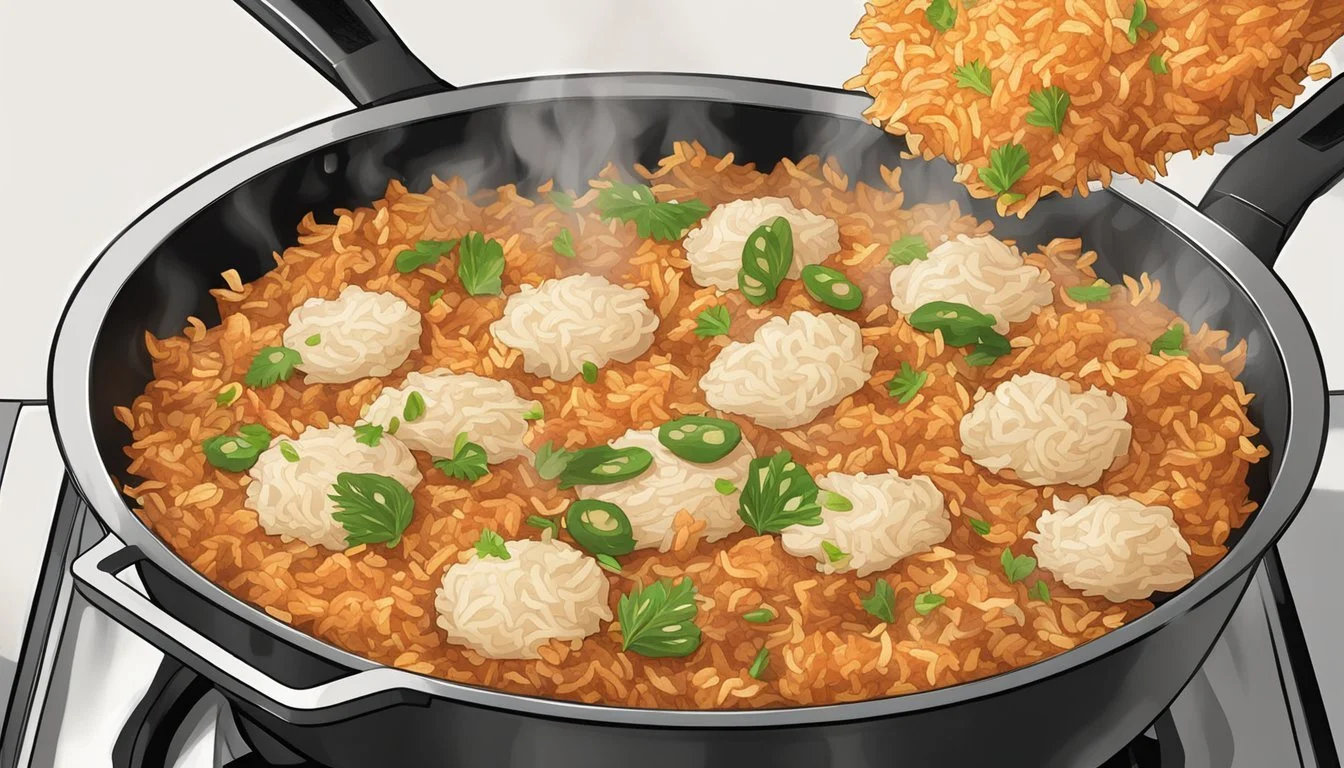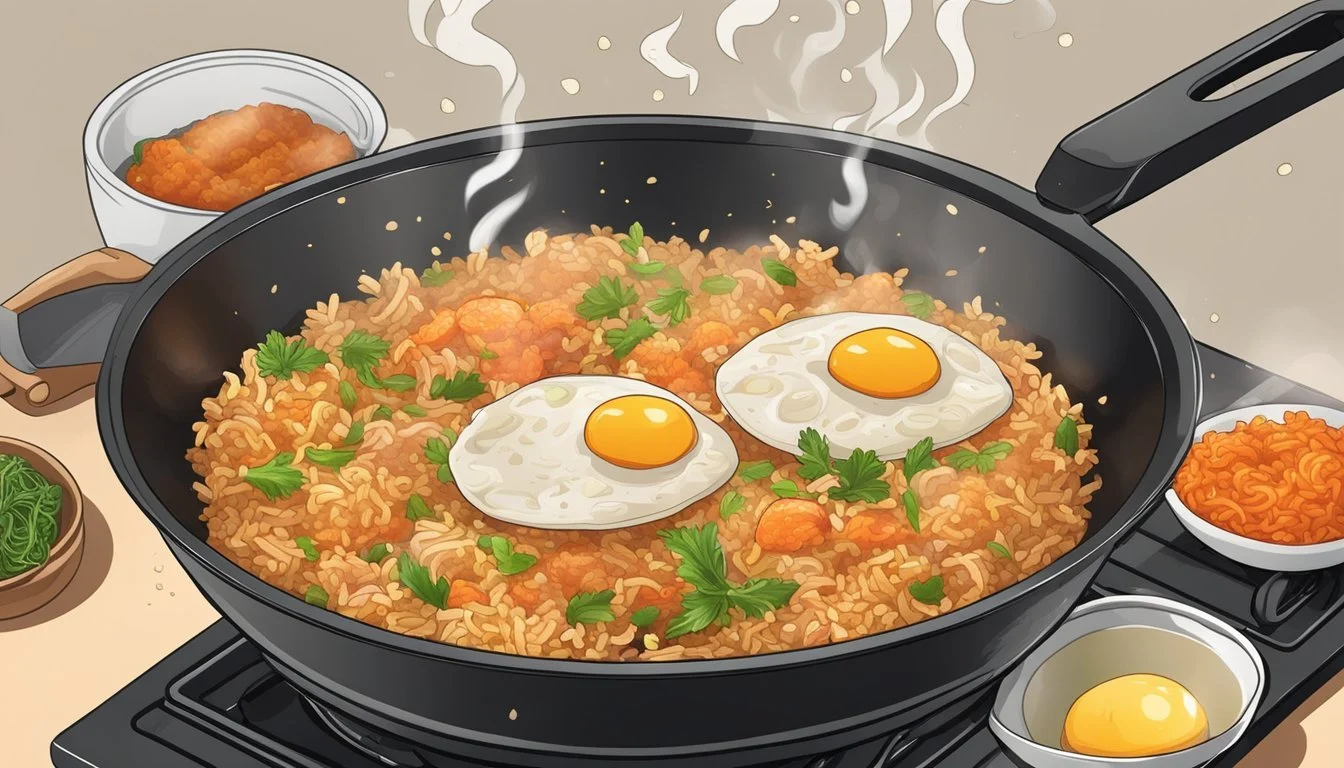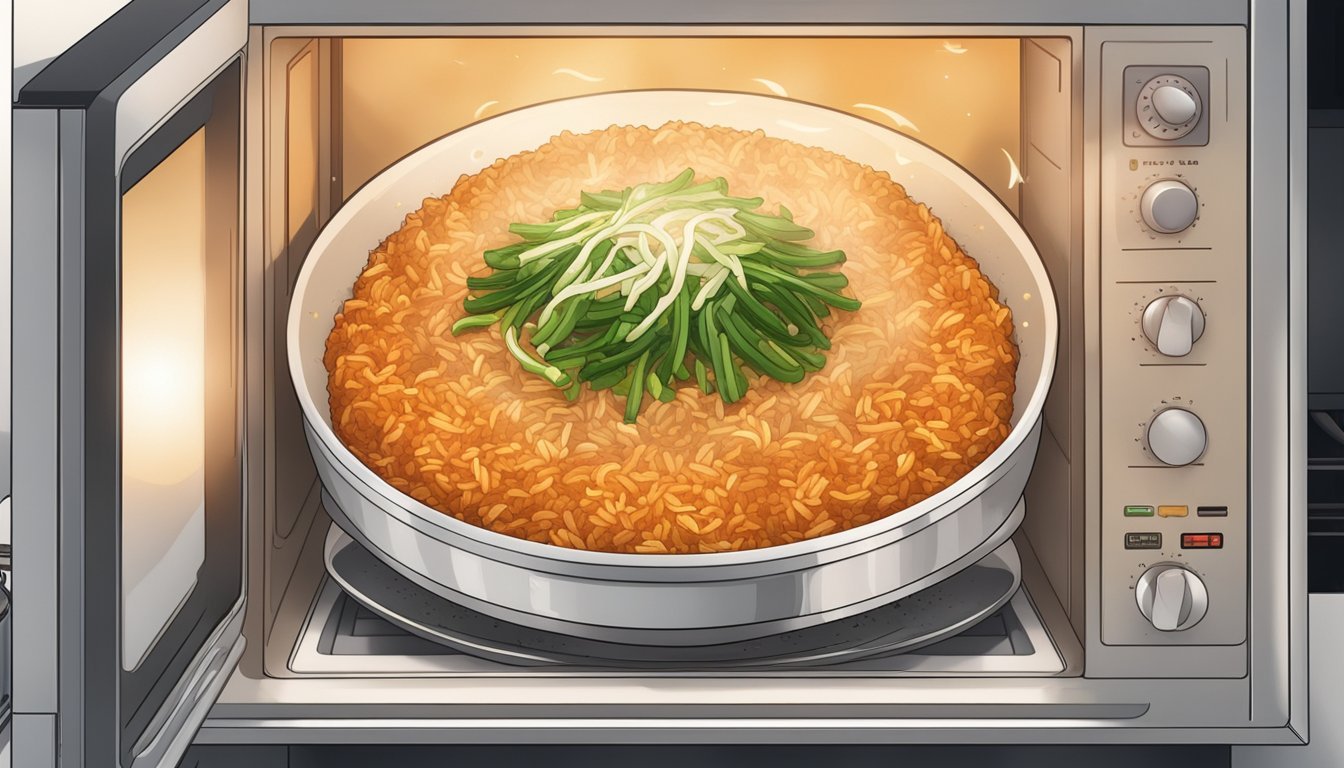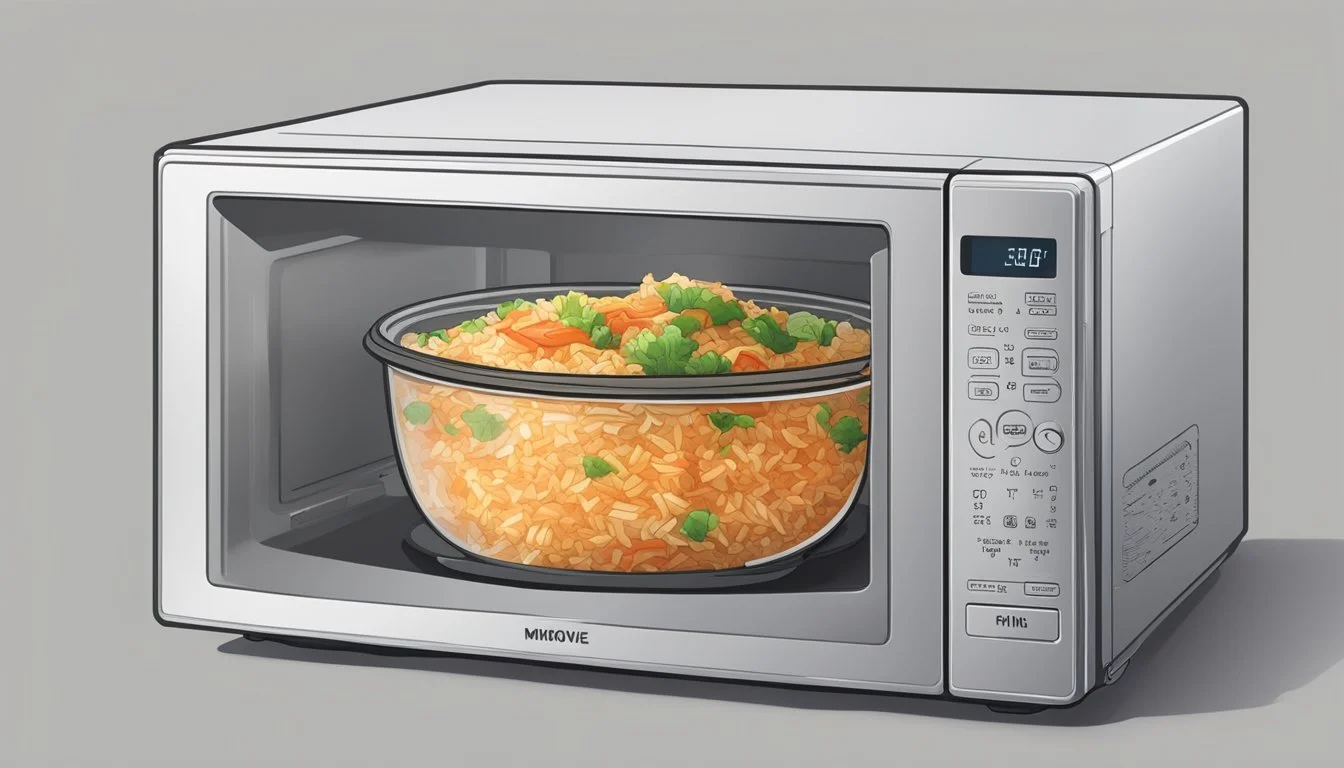Best Way to Reheat Kimchi Fried Rice
Tips for Crispiness and Flavor Retention
Kimchi fried rice, with its bold flavors and satisfying texture, often leaves people with delicious leftovers that they look forward to enjoying later. The unique combination of kimchi's tanginess and the fried rice's heartiness does, however, pose a challenge when it comes to reheating. To preserve the dish's signature crispiness and depth of flavor, one must utilize reheating methods that maintain the integrity of the original dish.
The key lies in choosing a reheating technique that not only warms the rice thoroughly but also rejuvenates its texture and aroma without drying it out. Traditional stovetop methods, the innovative use of kitchen appliances like air fryers or microwaves with adapted techniques, and the judicious addition of liquids all play pivotal roles. These practices ensure that the kimchi fried rice remains both safe to consume and delightful to the palate.
Employing the right combination of heat and moisture is essential to revive the fried rice to its just-cooked freshness. It requires careful heat regulation and strategic stirring to distribute warmth and prevent sticking. By following tried and true reheating practices, one can restore the kimchi fried rice's crispy edges and succulent flavor, making it nearly indistinguishable from its initial serving.
Understanding Kimchi Fried Rice
Kimchi fried rice is a beloved dish known for its robust flavors and versatility, combining traditional Korean ingredients with a classic Chinese cooking technique.
Key Ingredients and Flavors
Kimchi fried rice, colloquially known as kimchi bokkeumbap in Korean, leans heavily on kimchi for its distinct taste that is both spicy and tangy. The following table summarizes the core components and their roles in the dish:
Ingredient Role Kimchi Provides a tangy and spicy base flavor. Rice Serves as the starchy component that absorbs sauces and kimchi flavors. Garlic Adds aromatic intensity to the dish. Onions Contributes sweetness and texture. Green Onions Adds a fresh, sharp accent to finish the dish. Sesame Oil Imparts a nutty essence and helps to crisp the rice. Soy Sauce Enhances umami and saltiness. Eggs Offers richness and can provide a delicate balance to the spicy kimchi.
Beyond these basics, the dish can be customized with various proteins such as chicken, shrimp, or beef, and additional vegetables like spinach or frozen mixed veggies to create variations like chicken fried rice or vegetable fried rice. Spices and seasonings can be adjusted to taste, often including Korean staples like gochujang (red chili paste) to dial up the heat and complexity.
The key to a distinctive kimchi fried rice lies in achieving both a flavorful and texturally pleasing experience where the rice has a slight crispness, and each ingredient speaks to the dish's authenticity and heartiness.
Preserving and Storing Leftovers
When storing leftover kimchi fried rice, it's vital to use proper methods to retain its crispness and flavors while ensuring food safety.
Fried Rice Storage Tips
For leftover fried rice, promptly storing it in an airtight container is crucial to maintain quality. Cooling it down to room temperature quickly reduces the risk of bacterial growth. Once cooled, the fried rice should be transferred to the airtight container and sealed tightly. Refrigeration is the next step; the container should be placed in the refrigerator to ensure that the rice remains fresh. Leftover rice kept in the refrigerator is best consumed within 1-2 days to enjoy not only its taste but also its texture.
Do:
Cool to room temperature quickly.
Transfer to an airtight container.
Refrigerate at a consistent temperature.
Don't:
Leave the rice at room temperature for more than an hour.
Use containers that are not sealed properly.
Preventing Food Poisoning
Leftover rice, if improperly stored, can pose a risk for food poisoning due to bacteria such as Bacillus cereus. This bacterium can survive cooking and proliferates if the rice remains at room temperature for too lengthy of a period. To prevent foodborne illnesses, it is imperative to refrigerate leftover fried rice promptly. Reheat only the portion you intend to consume immediately to a temperature of 165°F or higher, which can help inactivate most of the bacteria that might have developed.
Store the rice in the refrigerator within an hour of cooking.
Reheat to 165°F before consuming.
Consume refrigerated leftovers within a day or two for best quality and safety.
Preparation for Reheating
When reheating kimchi fried rice, one should prioritize maintaining crispiness and preserving the dish’s flavors. The correct tools and equipment are vital for achieving the best results.
Tools and Equipment Required
In preparation for reheating kimchi fried rice, individuals will need the following tools, depending on the preferred reheating method:
Stovetop Reheating: A skillet, wok, or non-stick pan is necessary. The users should ensure the cookware provides even heat distribution.
Oven Reheating: An oven and an oven-safe dish are required. Aluminum foil can be useful to cover the rice, preventing it from drying out.
Microwave Reheating: A microwave-safe plate or dish is indispensable. Covering the dish with a microwave-safe lid or a damp paper towel helps in retaining moisture.
Air Fryer Reheating: Those opting to use an air fryer should ensure the availability of an air fryer basket. It's crucial to not overcrowd the basket to allow even crisping.
Regardless of the method, users may also need a fork or spoon to fluff and evenly distribute the rice after reheating, which helps in maintaining the texture and ensuring that the heat is evenly spread throughout the dish. Each piece of equipment should be clean and readily available before beginning the reheating process to minimize any disruption and to maintain the integrity of the kimchi fried rice's flavor and texture.
Reheating on the Stovetop
Reheating kimchi fried rice on the stovetop is ideal for restoring the dish's crisp texture and vibrant flavor. The stovetop method allows for precise heat control and quick reheating.
Stovetop Method
To reheat kimchi fried rice on the stovetop, one should heat a pan over medium heat. It's preferable to use a non-stick pan to prevent sticking and ensure an even reheat. The cook should add a small amount of cooking oil or butter to the pan, just enough to lightly coat the surface.
Heat the pan: Medium heat
Add: A small amount of oil or butter
Stir-Frying Technique
Once the pan is heated and the oil is glistening, the fried rice can be added. Stir-frying the rice ensures that each grain is heated evenly. This method allows for bits of rice to crisp up, closely mimicking the texture when it was initially cooked.
Steps for Stir-Frying:
Add rice: Ensure the rice is spread out evenly in the pan.
Stir occasionally: To prevent burning and promote even heating.
Steam-Frying for Moisture Retention
If the fried rice feels dry, adding a little bit of water or broth can introduce moisture back into the dish without making it soggy. Steam-frying involves stirring the rice as it heats up and allowing steam to penetrate the grains, which restores moisture lost during refrigeration.
Add moisture: A splash of water or broth, if needed
Cover: With a lid briefly to steam
Uncover and stir: Until heated through and moisture is evenly distributed
Oven Reheating Strategies
When reheating kimchi fried rice in the oven, the goals are to restore the rice's warmth, maintain its flavorful character, and preserve a slightly crispy texture. Strategies include properly preheating the oven and effectively managing moisture to prevent dryness.
Oven Method
To reheat kimchi fried rice using the oven, one should first preheat the oven to 350°F (175°C). Spread the leftover rice in an even layer on a baking sheet or oven-safe dish. If the rice has clumped together, break it apart gently to allow for even heating.
Preheat Oven: 350°F (175°C)
Baking Time: Approx. 10-15 minutes
Baking Sheet: Preferably lined with foil
It's crucial to stir the fried rice occasionally during the baking process to ensure all parts receive equal heat exposure. The oven's consistent heating environment is ideal for large batches and can produce a desirable crispiness if monitored carefully.
Preventing Dryness in the Oven
Reheating fried rice in an oven can often lead to excessive dryness unless one takes steps to retain moisture. Introduce a small amount of liquid to keep the rice from drying out. A light sprinkle of water, broth, or even kimchi juice can provide the necessary moisture.
Moisture: Add a tablespoon of liquid per cup of rice
Coverage: Lightly cover the baking dish with foil to trap steam
The foil covering should be loose to allow for some airflow while still holding in enough steam to re-moisturize the rice. Ensure that the rice is not swimming in liquid as too much can make it soggy. The right balance will refresh the rice without compromising its crisp quality.
Microwave Reheating Guidelines
Reheating kimchi fried rice in the microwave can be an efficient way to enjoy your leftovers. The following guidelines will ensure the rice retains its texture and flavor, avoiding any undesirable cold spots.
Microwave Method
To reheat kimchi fried rice, one should spread the rice evenly in a microwave-safe dish to promote uniform heating. Before placing the dish in the microwave, sprinkle a few drops of water over the rice. This adds moisture to prevent the rice from drying out. It's advisable to cover the rice with a damp paper towel or microwave-safe lid to trap steam during reheating. Set the microwave to high power and heat in intervals of one minute, stirring the rice between each interval to ensure even reheating.
Maintaining Rice Texture
The key to maintaining the signature texture of kimchi fried rice lies in not overdoing the moisture nor allowing the rice to dry out. Subtly moisten the rice with water or a small amount of oil but be careful not to make it soggy. Lightly fluff the rice with a fork after each interval to help separate the grains and preserve the dish's texture.
Avoiding Cold Spots
Cold spots occur when food is unevenly heated in a microwave. To prevent this, stir the fried rice thoroughly after each minute of cooking. Reheat until an internal temperature of 165°F (74°C) is reached, which is the safe temperature for leftover food. Further ensure even heating by arranging the rice in a thin, even layer across the dish; this allows the microwaves to penetrate the dish uniformly. If necessary, divide the rice into smaller portions, as they reheat more evenly than larger quantities.
The Role of Steam in Reheating
When reheating kimchi fried rice, utilizing steam plays a pivotal role in preserving the dish's moisture and enhancing its flavor profile.
Steaming Technique
To effectively reheat kimchi fried rice with steam, one should add a small amount of water to the frying pan and cover it with a lid. This process introduces moisture into the environment, which is essential for preventing the rice from drying out. Steam helps to uniformly distribute heat, ensuring that the rice regains its original texture without becoming too soft or mushy. It's important to stir the rice occasionally and to adjust the heat as needed to maintain a gentle steam without overcooking. Using a lid is crucial in this technique to trap the steam and create a convection-like effect that warms the rice evenly.
Alternative Reheating Methods
When looking to maintain the crispiness and flavor of kimchi fried rice, utilizing kitchen appliances like the air fryer and Instant Pot offers efficient alternatives to traditional methods.
Using the Air Fryer
An air fryer promotes even reheating and can help preserve the crispy texture of the rice. To effectively use the air fryer for reheating kimchi fried rice, follow these steps:
Preheat the air fryer to 356°F (180°C).
Place kimchi fried rice in a heat-proof bowl or wrap in foil to prevent drying out.
Stir in a little water or broth if the rice appears dry.
Set the air fryer for 3-5 minutes.
Stir the rice halfway through the cooking time to ensure even heating.
Remember, the air fryer circulates hot air around the food, which can crisp the edges of the rice giving it a desirable texture.
Instant Pot Reheating
The Instant Pot can also serve as a handy appliance for reheating rice while aiding in retaining moisture. To use the Instant Pot for reheating:
Add a cup of water to the inner pot and place a trivet inside.
Spread the kimchi fried rice in an oven-safe bowl and place it on the trivet.
Cover the bowl with a lid or aluminum foil to minimize moisture loss.
Use the Steam function and set the Instant Pot for about 5 minutes.
Once done, perform a quick release and carefully remove the bowl.
This method heats the rice through steam, which can help in maintaining the rice's moisture without sacrificing its flavor.
Additional Tips for Enhancing Flavor
When reheating kimchi fried rice, flavor enhancement is just as crucial as maintaining its crispiness. Implementing these additional steps can help ensure that the reheated dish is just as tantalizing as when it was freshly made.
Incorporating Extra Ingredients
To bolster the flavor profile of kimchi fried rice, one may consider adding a variety of aromatic ingredients. Drizzling a bit of sesame oil over the rice after reheating can introduce a nutty essence that compliments the tanginess of kimchi. For those seeking a more personalized touch, incorporating additional vegetables or proteins such as green onions, tofu, or diced meats before reheating can significantly enrich the overall flavor and texture.
Adjusting Seasoning After Reheating
The key to maximum flavor lies in the careful adjustment of seasoning post-reheating. It's advisable to taste the fried rice first and then consider enhancing with a splash of soy sauce for umami depth or a pinch of salt and pepper to amplify the existing flavors. Gentle stirring during the reheating process distributes these seasonings evenly, ensuring every bite is equally savory and satisfying.
Safety Considerations When Reheating
Ensuring that kimchi fried rice is reheated safely is crucial to prevent foodborne illnesses. The key is maintaining the right temperature and handling the rice properly before and after reheating.
Avoiding Foodborne Illness
One significant threat associated with improperly reheated rice is Bacillus cereus, a bacterium that can lead to food poisoning. This bacterium can survive cooking and proliferate if the rice is left at room temperature. To reduce the risk of illness, one should always refrigerate leftover kimchi fried rice within two hours of cooking, keeping it in a refrigerator at a temperature below 40°F (4°C).
When reheating, it is essential to bring the rice to a temperature that is piping hot throughout, which means achieving an internal temperature of 165°F (74°C) for at least 2 minutes. This can effectively kill any harmful bacteria that might have grown.
Here is a brief guideline for safe reheating:
Refrigerate rice as soon as possible after cooking.
Store in airtight containers to limit bacteria exposure.
Reheat to an internal temperature of 165°F (74°C).
By following these steps, consumers can enjoy their kimchi fried rice reheated with both flavor and safety in mind.
Serving and Presentation
The success of serving kimchi fried rice lies in maintaining its crispy texture and rich flavor even after reheating. Presentation should not only be appealing to the eyes but also serve to entice the palate.
Proper Ways to Serve Reheated Kimchi Fried Rice
To serve reheated kimchi fried rice, one should consider:
Temperature: Ensure that the fried rice is served hot. This not only enhances the flavors but also contributes to the overall texture.
Texture: Aim to preserve the crispiness of the rice. If the rice was reheated in a microwave, it could benefit from a brief toss in a pan over medium-high heat to renew its crispness.
Accompaniments: Pair with simple, contrasting side dishes to balance the kimchi's bold flavor. Grilled proteins or a fresh salad can complement the meal well.
Presentation tips include:
Plating: Use a warm plate to serve the fried rice to retain heat. Mounding the rice in the center can provide an enticing visual focus.
Garnish: To enhance the aesthetic appeal, one can top the fried rice with sesame seeds, sliced green onions, or a fried egg. This not only adds color contrast but also additional layers of flavor and texture.
Proportion: Serve appropriate portion sizes that are visually satisfying yet practical for individual consumption. This can often be a single cup or bowl per person.
When serving kimchi fried rice, it's important to consider that the dish is often enjoyed as a main dish due to its bold flavors and hearty nature. Presentation should mirror the care with which it’s reheated, ensuring every bite is as enjoyable as the first.







